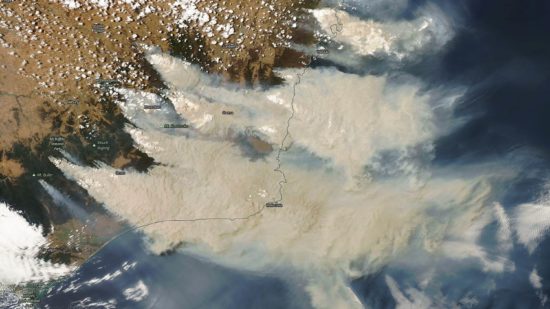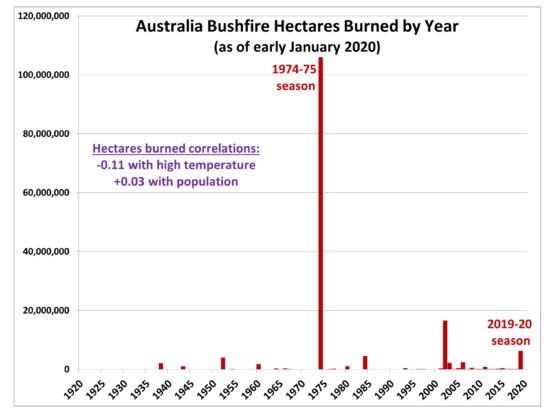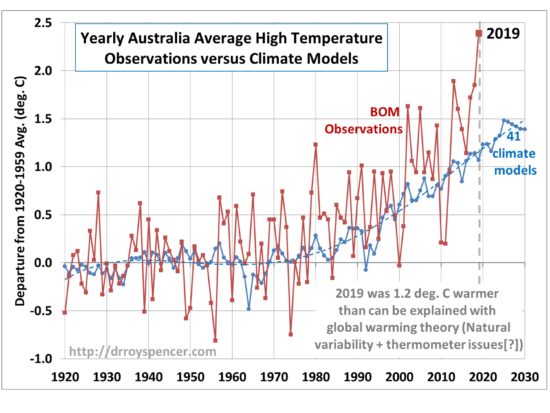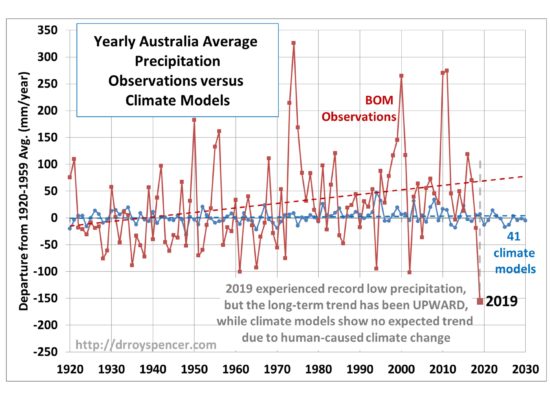
Summary Points
1) Global wildfire activity has decreased in recent decades, making any localized increase (or decrease) in wildfire activity difficult to attribute to ‘global climate change’.
2) Like California, Australia is prone to bushfires every year during the dry season. Ample fuel and dry weather exists for devastating fires each year, even without excessive heat or drought, as illustrated by the record number of hectares burned (over 100 million) during 1974-75 when above-average precipitation and below-average temperatures existed.
3) Australian average temperatures in 2019 were well above what global warming theory can explain, illustrating the importance of natural year-to-year variability in weather patterns (e.g. drought and excessively high temperatures).
4) Australia precipitation was at a record low in 2019, but climate models predict no long-term trend in Australia precipitation, while the observed trend has been upward, not downward. This again highlights the importance of natural climate variability to fire weather conditions, as opposed to human-induced climate change.
5) While reductions in prescribed burning have probably contributed to the irregular increase in the number of years with large bush fires, a five-fold increase in population in the last 100 years has greatly increased potential ignition sources, both accidental and purposeful.
Historical Background
Australia has a long history of bush fires, with the Aborigines doing prescribed burns centuries (if not millennia) before European settlement. A good summary of the history of bushfires and their management was written by the CSIRO Division of Forestry twenty-five years ago, entitled Bushfires – An Integral Part of Australia’s Environment.
The current claim by many that human-caused climate change has made Australian bushfires worse is difficult to support, for a number of reasons. Bushfires (like wildfires elsewhere in the world) are a natural occurrence wherever there is strong seasonality in precipitation, with vegetation growing during the wet season and then becoming fuel for fire during the dry season.
All other factors being equal, wildfires (once ignited) will be made worse by higher temperatures, lower humidity, and stronger winds. But with the exception of dry lightning, the natural sources of fire ignition are pretty limited. High temperature and low humidity alone do not cause dead vegetation to spontaneously ignite.
As the human population increases, the potential ignition sources have increased rapidly. The population of Australia has increased five-fold in the last 100 years (from 5 million to 25 million). Discarded cigarettes and matches, vehicle catalytic converters, sparks from electrical equipment and transmission lines, campfires, prescribed burns going out of control, and arson are some of the more obvious source of human-caused ignition, and these can all be expected to increase with population.
Trends in Bushfire Activity
The following plot shows the major Australia bushfires over the same period of time (100 years) as the five-fold increase in the population of Australia. The data come from Wikipedia’s Bushfires in Australia.

As can be seen, by far the largest area burned occurred during 1974-75, at over 100 million hectares (close to 15% of the total area of Australia). Curiously, though, according to Australia Bureau of Meteorology (BOM) data, the 1974-75 bushfires occurred during a year with above-average precipitation and below-average temperature. This is opposite to the narrative that major bushfires are a feature of just excessively hot and dry years.
Every dry season in Australia experiences excessive heat and low humidity.
Australia High Temperature Trends
The following plot (in red) shows the yearly average variations in daily high temperature for Australia, compared to the 40-year average during 1920-1959.

Also shown in Fig. 2 (in blue) is the average of 41 CMIP5 climate models daily high temperature for Australia (from the KNMI Climate Explorer website). There are a few important points to be made from this plot.
First, if we correlate the yearly temperatures in Fig. 2 with the bushfire land area burned in Fig. 1, there is essentially no correlation (-0.11), primarily because of the huge 1974-75 event. If that year is removed from the data, there is a weak positive correlation (+0.19, barely significant at the 2-sigma level). But having statistics depend so much on single events (in this case, their removal from the dataset) is precisely one of the reasons why we should not use the current (2019-2020) wildfire events as an indicator of long-term climate change.
Secondly, while it is well known that the CMIP5 models are producing too much warming in the tropics compared to observations, in Australia just the opposite is happening: the BOM temperatures are showing more rapid warming than the average of the climate models produces. This could be a spurious result of changes in Australian thermometer measurement technology and data processing as has been claimed by Jennifer Marohasy.
Or, maybe the discrepancy is from natural climate variability. Who knows?
Finally, note the huge amount of year-to-year temperature variability in Fig. 2. Clearly, 2019 was exceptionally warm, but a good part of that warmth was likely due to natural variations in the tropics and subtropics, due to persistent El Nino conditions and associated changes in where precipitation regions versus clear air regions tend to get established in the tropics and subtropics.
Australia Precipitation Trends
To drive home the point that any given year should not be used as evidence of a long-term trend, Australia precipitation provides an excellent example. The following plot is like the temperature plot above (Fig. 2), but now for precipitation as reported by the BOM (data here).

We can see that 2019 was definitely a dry year in Australia, right? Possibly a record-setter. But the long-term trend has been upward (not downward), again illustrating the fact that any given year might not have anything to do with the long-term trend, let alone human-induced climate change.
And regarding the latter, the blue curve in Fig. 3 shows that the expectation of global warming theory as embodied by the average of 41 climate models is that there should have been no long-term trend in Australia precipitation, despite claims by the media, pseudo-experts, and Hollywood celebrities to the contrary.
It should be kept in mind that wildfire risk can actually increase with more precipitation during the growing season preceding fire season. More precipitation produces more fuel. In fact, there is a positive correlation between the precipitation data in Fig. 3 and bushfire hectares burned (+0.30, significant at the 3-sigma level). Now, I am not claiming that hot, dry conditions do not favor more bushfire activity. They indeed do (during fire season), everything else being the same. But the current 2019-2020 increase in bushfires would be difficult to tie to global warming theory based upon the evidence in the above three plots.
Global Wildfire Activity
If human-caused climate change (or even natural climate change) was causing wildfire activity to increase, it should show up much better in global statistics than in any specific region, like Australia. Of course any specific region can have an upward (or downward) trend in wildfire activity, simply because of the natural, chaotic variations in weather and climate.
But, contrary to popular perception, a global survey of wildfire activity has found that recent decades have actually experienced less fire activity (Doerr & Santin, 2016), not more. This means there are more areas experiencing a decrease in wildfire activity than there are areas experiencing more wildfires.
Why isn’t this decrease being attributed to human-caused climate change?
Concluding Comments
There are multiple reasons why people have the impression that wildfires are getting worse and human-caused climate change is to blame. First, the news tends to report only disasters… not a lack of disasters. The desire for more clicks means that headlines are increasingly sensationalized. The media can always find at least one expert to support the desired narrative.
Second, the spread of news is now rapid and it penetrates deeply, being spread through social media.
Third, an increasing number of environmental advocacy groups seize upon any natural disaster and declare it to be caused by increasing CO2 in the atmosphere. The hyperbolic and counter-factual claims of Extinction Rebellion is one of the best recent examples of this.
This is all against a backdrop of government funded science that receives funding in direct proportion to the threat to life and property that the researcher can claim exists if science answers are not found, and policy is not changed. So, it should come at no surprise that there is political influence on what research gets funding when the outcome of that research directly affects public policy.
My personal opinion, based upon the available evidence, is that any long-term increase in wildfire activity in any specific location like Australia (or California) is dominated by the increase in human-caused ignition events, whether they be accidental or purposeful. A related reason is the increasing pressure by the public to reduce prescribed burns, clearing of dead vegetation, and cutting of fire breaks, which the public believes to have short term benefits to beauty and wildlife preservation, but results in long term consequences that are just the opposite and much worse.
Recent news reports claim that dozens of people have been arrested in Australia on arson charges, a phenomenon which we must assume has also increased by at least five-fold (like population) in the last 100 years. Accidental sources of ignition also increase in lockstep with the increasing population and all of the infrastructure that comes along with more people (vehicles, power lines, campfires, discarded matches and cigarettes, etc.)
So, to automatically blame the Australian bushfires on human-caused climate change is mostly alarmist nonsense, with virtually no basis in fact.

 Home/Blog
Home/Blog




thanks for sharing your information with us , such a amazing information
Çok yararlı bir makale olmuş. Severek takip ediyorum. Teşekkür ederim.
En iyi WordPress temaları ucuztema.net’de